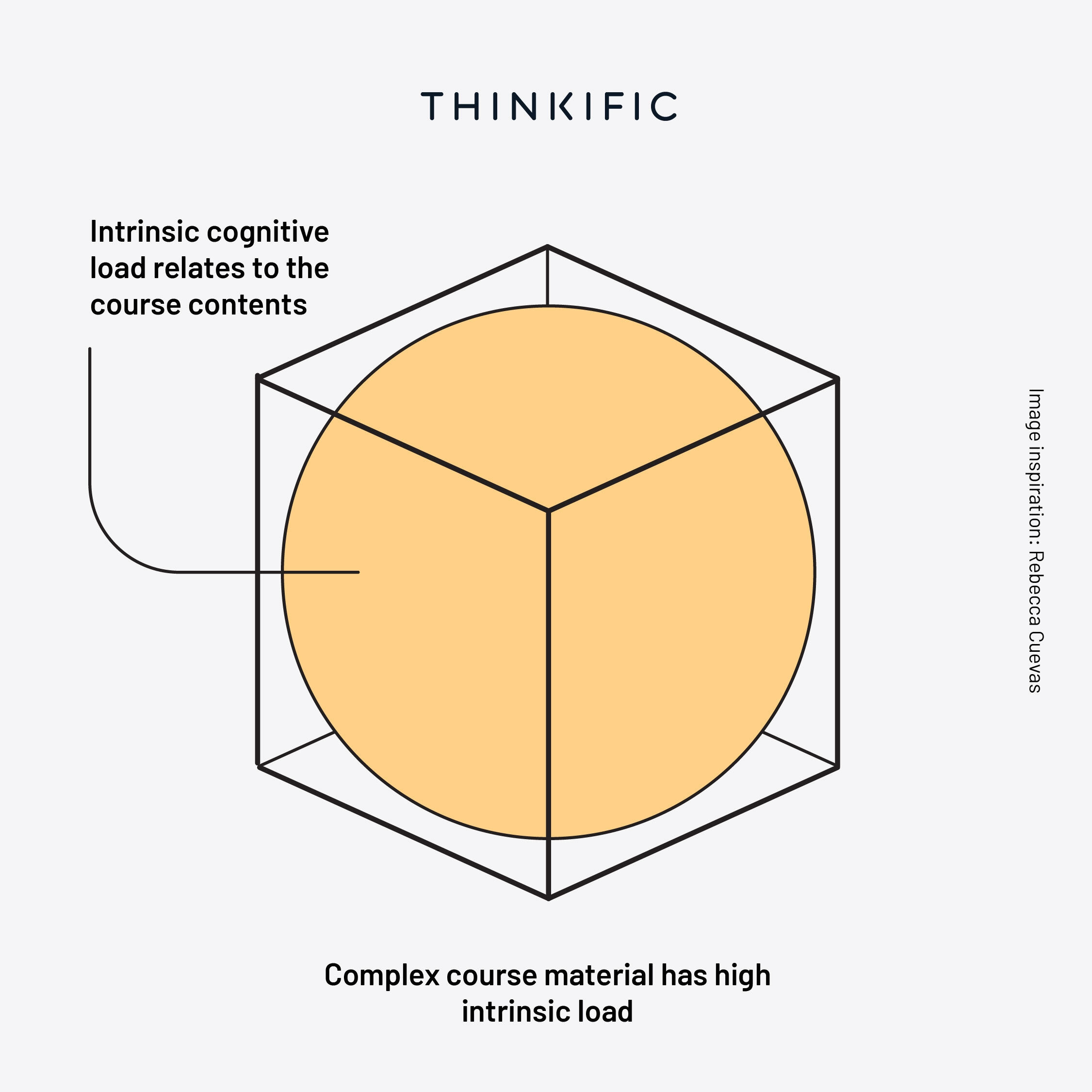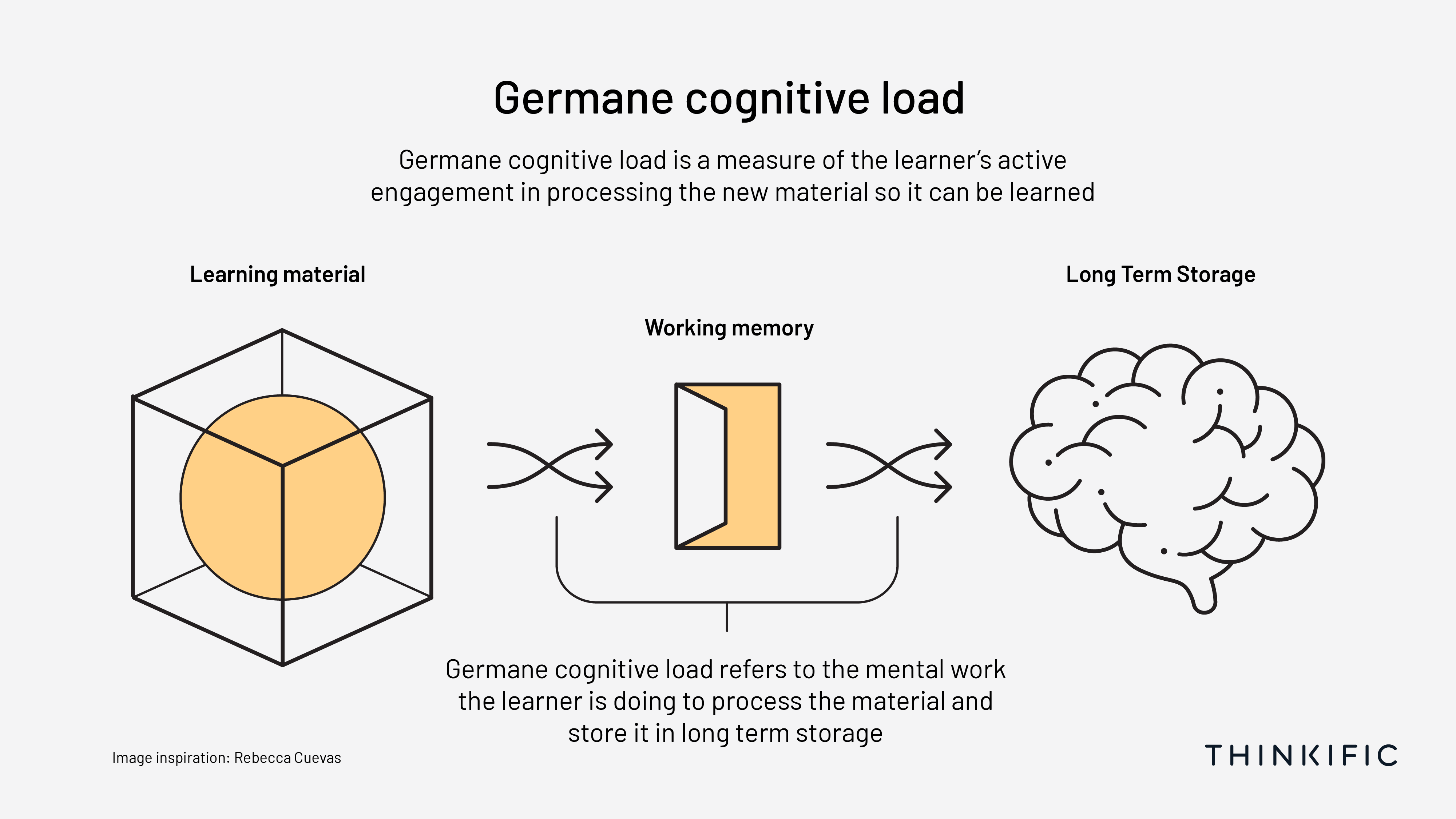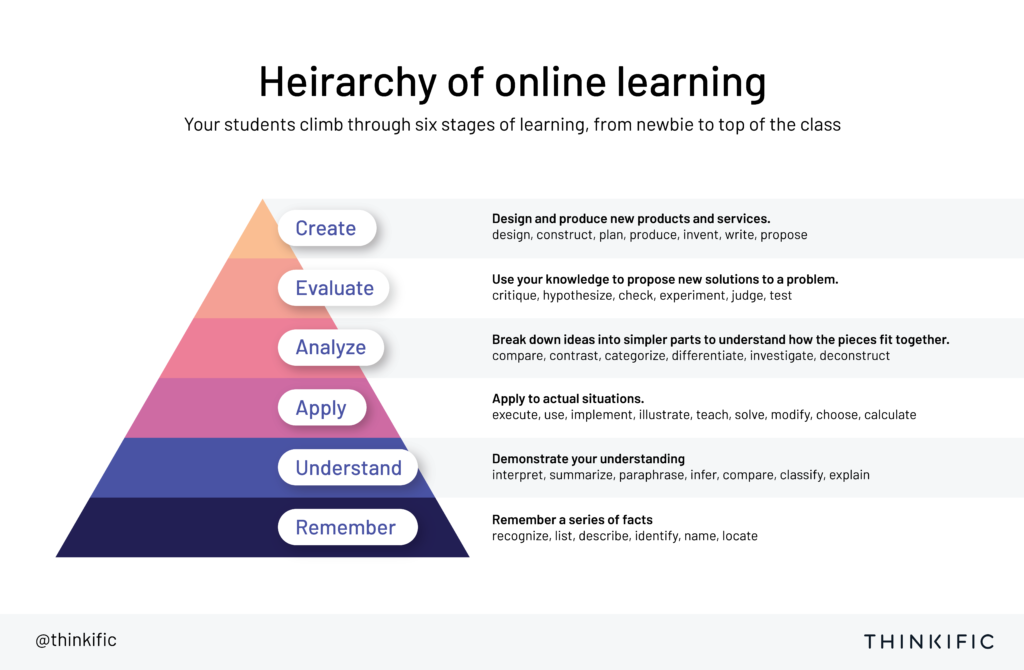Cognitive load theory: a game-changer for the success of your course
Three ways to make your course clear and easy to understand
Cognitive load theory is a framework that can help you make your course clear, engaging, and easy to understand. Learn about the three types of cognitive load and how each can potentially impact your course’s success and completion rates.
PROBLEM: The Expert Blind Spot
You are an expert on your course topic… so everything in your course is clear and easy for YOU to understand. But it can be very challenging for experts (like you) to see where non-experts (like your course participants) may find aspects of your course confusing or unclear.
It’s almost impossible to step into your learners’ shoes and see your course from their perspective.
To reverse an often-quoted phrase, “You can’t UN-know what you DO know”, which means that since you know so much about your course topic, it can be difficult to notice where novice learners may get lost or become confused.
This problem is so common and pervasive that there’s a research-based term for it. It’s called the “Expert blind spot”.
Wouldn’t it be great if there were a way to see past, through, and around the expert blind spot?
What’s needed is a tool that can help you know if and when your material might be confusing, too hard, or not engaging enough to keep your course participants’ attention.
Actually, there is such a tool! Cognitive load theory is a research-based framework that can help you pinpoint what might be making any aspect of your course difficult for learners to understand, and better yet, can help you not only find the problem but fix it.
The root of the problem
Let’s visualize your course, for a moment, as a conveyor belt delivering packages of fresh new information straight to your learners’ minds.
The problem is, that in order to get INTO your learners’ minds, the packages of information from your course have to first pass through a very narrow doorway.
The narrow doorway represents the tight limits of working memory, which is the part of the mind that processes new information coming in through the senses, so that it can be stored in a learner’s long-term memory vaults.
We don’t yet know if there are limits to the amount of information that can be stored in long-term memory, where the things we learn are kept once we’ve learned them. But the working memory that processes information so it CAN be stored in our long-term memory vaults, is very limited.
Research suggests we can only hold five to seven new items of information in our working memory, at any one time.

What that means in practical terms is that if you overload your course participants’ working memory with more new information than they can process at any one time, they’ll tune out everything but the first five to seven pieces of information to come down that (metaphorical) conveyor belt.
Exceeding the limits of working memory results in cognitive overload, which stops the learning process in its tracks (jamming up the conveyor belt in our metaphor, so no more packages of information get through).
Cognitive load theory is a body of research that gives us a way to understand what could be making it hard to get those packages of fresh new information through the narrow doorway of working memory, so your course participants can actually learn it.
SOLUTION: Cognitive load theory
You can think of cognitive load as the (metaphorical) weight, friction, or resistance involved in processing information so it can be learned.
There are three different types of cognitive load and there’s a different way to handle each of type.
Are you ready to solve the “make your course easy to understand” problem once and for all? Let’s dive in and see what cognitive load theory tells us about how to optimize learning in an online course.
The different types of cognitive load
Cognitive load theory identifies three different ways that the material in an online course can be hard to learn.
To go back to our metaphor, there are three factors that could make it hard to fit packages through a narrow doorway:
- Content that is large, heavy, or dense
- Packaging that is bulky or awkward in shape
- Processing that is lazy, ineffective, or absent
Now let’s think about how these three factors relate to helping people learn the material in your course.
Intrinsic cognitive load
1) The term “Intrinsic cognitive load” describes content that is large, heavy, or dense in its own right.
“Intrinsic” means that the cognitive load (the difficulty involved in learning the material) is an inherent, integral feature of the subject matter: the course content itself is complex, heavy, extensive, dense.

Intrinsic cognitive load is a property of the course material. A complex topic like electrical engineering or organic chemistry has high intrinsic cognitive load. In our metaphor about the packages going along the conveyor belt and through the narrow doorway of working memory into your learners’ minds, material with high intrinsic cognitive load creates a large heavy package because there’s a lot of material IN the package. And it may be difficult to get that large, heavy package through the narrow doorway of working memory.
What can you do? If your course material is complex, you can break it down into smaller, lighter segments. Smaller packages of information can more easily fit through the narrow doorway of working memory.
Don’t try to fit too much text onto a single PowerPoint slide. Don’t ask your course participants to process vast amounts of information without a break.
Another thing you can do is make sure your course participants have all the prior knowledge they need, to make learning this new material just a small step for them rather than a giant step.
If learners’ mental muscles are stronger, then the mental packages will be lighter because it’s easier for your learners to (cognitively) lift them.
You might create pre-requisite courses, or have students pass a qualifying exam to ensure they are ready for the new material in your course.
Extraneous cognitive load
2) Packaging that is bulky or awkward in shape
Extraneous cognitive load is bulk, weight, or complexity that’s been added to the course material but is not actually part of it. An example of extraneous cognitive load would be a complex, confusing explanation of a simple activity such as how to make a sandwich. This type of cognitive load is extraneous–it’s not part of the actual subject matter. The packaging (the way the material is being presented) doesn’t need to be bulky and awkward to contain the course content. The way the content is presented should be streamlined and simplified.

Some things that contribute to extraneous cognitive load include:
- Missing, incorrect or ineffective course structure
- Long, meandering lessons
- Poorly designed or confusingly organized materials
- Poorly structured learning activities
What can you do? You can minimize extraneous cognitive load through good learning design. If a course is structured the right way to promote learning, extraneous cognitive load will be minimized.
But… what is “the right way to promote learning”? And why does learning even need to be designed? Again, the answer comes down to the narrow doorway of working memory.
Have you seen those TV shows where expert designers help people live well and do amazing things (like play grand pianos and climb rock climbing walls) inside tiny houses?
An online course is like a tiny house, because of the very small amount of mental processing space people have available when learning online.
Good home design makes it possible to live well in a tiny house, and good learning design makes it possible to learn well in an online course.
The online teaching environment adds some unavoidable extraneous cognitive load to any subject, because learners have to use some of their mental processing power to find their way around the online interface and figure out what to do on their own, without a live instructor present in a physical classroom to help them out. (The Thinkific learning platform does a great job of keeping extraneous load to a minimum. But there’s no way to avoid extraneous cognitive load altogether in the online learning space). So good learning design is especially important for online courses.
How can you reduce extraneous cognitive load in your online course through good learning design?
- Have a clear, well-defined course learning goal: what is the transformation your course will deliver?
- Make sure everything in the course leads directly to the course learning goal
- Eliminate anything that does NOT lead directly to the course learning goal
- You can put the extraneous material into a different, more advanced, course if you want
- Be brutal! There is not a lot of mental processing space to spare
Germane cognitive load
3) Processing that is lazy, ineffective, or absent
Germane cognitive load: Now let’s focus on the workers getting those packages of information through the narrow doorway of working memory, into your course participants’ long term memory storage vaults.
In our metaphor, the “workers” represent the methods your course participants are using to process the learning…their active engagement in the learning task.
This type of engagement is not a direct part of the subject matter (it’s not “intrinsic” to the content) and it’s also not completely unrelated to the subject matter (it’s not “extraneous” to it).
This type of engagement is RELATED TO the subject matter and RELEVANT to learning it: it’s GERMANE to the subject matter because it helps learners do the mental work needed to process the material and store it in long-term memory.
This is where the saying “no pain, no gain” comes in. Your learners have to engage in SOME level of mental work to process information, in order to effectively learn it.

Germane cognitive load is not a bad thing. Your course needs to have some, to keep your learners involved and engaged in unpacking the information coming to them through your course.
The challenge is: how much germane cognitive load is enough?
How much is too little? And how much is too much?
If your course requires no mental work from your students, then it has too little germane cognitive load. People need to be mentally engaged and focused in order to actually learn new material, take it in, and make it their own. If they don’t do any mental work, the new material won’t stick.
In our metaphor, too little germane cognitive load is like lazy workers not doing anything to process the packages of new information. It’s like workers letting the packages fall right off the end of the conveyor belt onto the floor, or, getting the packages through the narrow doorway of working memory but then not labeling them properly or storing them on shelves where they can later be found.
If your course is engaging and requires learners to participate and do work that is directly related to the learning task, it has just the right amount of germane cognitive load. You can tell you’ve got the right amount of germane cognitive load if your course participants are participating, engaging with the material, and working hard to overcome any challenges they face.
In order to learn something new, we have to be (gently) guided out of our comfort zone and into the “Zone of proximal development”, the next stage we are ready for in our learning journey.
Building the right amount of germane cognitive load into your course will keep your learners in their zone of proximal development… ready to step out of their comfort zones and try new things, without being overwhelmed.
In our metaphor, this is like having happy workers efficiently processing the packages of information on the conveyor belt to get them through the narrow doorway of working memory.
What can you do?
You achieve that by building engagement into your learning activities, treating the learner as a whole person who uses multiple sensory modalities and multiple intelligences to take in and process new information.
Just having learners sit in front of a screen watching long talking-heads style videos won’t achieve this.
Instead, help learners use all their senses to take in information, and use different ways of processing information once they’ve taken it in. Here’s an activity you can use to brainstorm how to include a variety of different types of learning activities in your online course, to keep learners engaged on all levels.
So far, it sounds like germane cognitive load is a GOOD thing, right? You want your learners to be actively involved in learning. But it’s always possible to have too much of a good thing, and the same is true of germane cognitive load. In our metaphor, this would be like having the workers so involved in a competition or game, that they forget to notice what’s actually IN the packages they are processing. If you’ve ever been in a classroom situation where you end up remembering that you played a fun learning game, but not remembering anything about the actual lesson material, you’ve experienced too much germane cognitive load. Another example of “too much” would be a learning game so complex that it takes away from the actual learning.
How this applies to your course
What does this mean for you as you create your online course?
You can use the three types of cognitive load as a way of evaluating whether your course material is clear and engaging, or confusing and hard to connect with. An important thing to notice is that your course participants themselves are part of this equation.
Managing intrinsic cognitive load
To manage intrinsic cognitive load, break large, complex topics up into smaller segments and make sure learners have the prior knowledge they need to be ready to access the material.
Material that would be very hard for a two-year-old to learn, might be a breeze for an advanced nuclear physicist. Whether your course content has high intrinsic cognitive load or not, depends in part on the prior knowledge your course participants already possess, relative to the subject matter.
You may need to do market research with your target audience to find out how much they already know, relative to your subject matter, and adjust the way you set up your course to make sure you’re teaching them exactly what they need to learn next, without overwhelming them.
Reducing extraneous cognitive load
To reduce extraneous cognitive load, implement good learning design at every level of your course: the course level, the lesson level, and within each individual media item (these are called “learning objects”) in your course.
Using learning design best practices will help ensure that high extraneous cognitive load does not disrupt your course participants’ ability to get the most from your course.
- At the course level: Set up the modules or chapters (the big sections of your course) in a logical way that works for the specific type of learning your course requires. A “how-to” course requires a different course structure than a course designed to promote a mindset change, for example. When your course structure works with, rather than against, the natural way people learn the type of material in it, the mental friction that results from high cognitive load, is reduced.
- At the lesson level:
- Make sure that all your content leads directly to the lesson’s learning goal
- Don’t put too much content on a single slide…present small chunks at a time
- Include relevant graphics to provide context
- Keep videos short
- Allow the learner to control the pace of instruction as much as possible
Optimizing germane cognitive load
To optimize germane cognitive load, learners should not just be sitting passively while the information in your course comes at them or flows past them… but rather should have continual opportunities for active participation in your course, in ways that give them a feeling that they are taking effective action to promote their own learning, and are seeing tangible, concrete, immediate results.
Optimizing cognitive load in your online course is a constant balancing act.
Many factors come into play to determine the levels of cognitive load presented by your course material.
- Your learners’ level of prior knowledge interacts with the complexity of the subject matter to determine levels of intrinsic cognitive load
- The navigational constraints of online learning increase extraneous cognitive load for everyone in ways that have to be accounted for
- Optimizing germane cognitive load with interactive learning activities must be weighed against any concurrent increase in navigational complexity
You can manage intrinsic cognitive load, decrease extraneous cognitive load, and optimize germane cognitive load by applying targeted learning design best practices.
The central, most important thing to remember is that your course must have ONE clear, overall learning goal. There must be a specific transformation that your course delivers, a specific way that your course participants will be different and better as a direct result of taking your course.
Then, everything IN your course must lead directly TO the course learning goal in a sequential manner that builds on itself in small, manageable, steps.
Designing ways for learners to take effective action on their own behalf (rather than just having them sit passively while the information in your course comes flying AT them), helps optimize germane cognitive load.
Giving learners continual small wins as they achieve success at each step of a carefully planned learning journey, balances all three types of cognitive load: it keeps intrinsic cognitive load low, removes extraneous cognitive load, and optimizes germane cognitive load.
How do you know if the steps you’re building into your course are small enough and are following the best sequential pathway to manage cognitive load?
One way is to use Bloom’s Taxonomy as your guide. Bloom’s taxonomy is a tool that educators use to classify the different types of thinking skills needed to learn something new, in a hierarchical manner. At the bottom of the hierarchy are the lower-level thinking skills:
- Remembering
- Understanding
- Applying what was learned
Building on these are the higher-level thinking skills:
- Analyzing
- Evaluating
- Creating something new

Bloom’s taxonomy is a useful tool for optimizing cognitive load. If you start with the lower-level thinking skills and work your way up one step at a time, you will ensure that you’re keeping the steps you ask your course participants to take, small enough to keep cognitive load within manageable levels each step of the way.
What does this mean in practice, for your course?
It means that you should build in learning activities that promote the lower level thinking skills of remembering and understanding, early in a course or lesson, and only ask your learners to use complex higher-level thinking skills like analyzing, evaluating, and creating something new, once you’re sure they‘ve mastered those earlier foundational skills.
Cognitive load theory is a very useful framework for any online course creator to keep in their toolkit. If anything in your course seems confusing or unclear, or if your learners are getting stuck at any point in your course, ask yourself whether the problem is caused by:
- Content that is inherently complex (high intrinsic cognitive load)
- Instruction that is not directly related to the learning goal (high extraneous cognitive load)
- Activities that are not engaging (overly low germane cognitive load), or distracting from the actual content to be learned (overly high germane cognitive load)
You can use cognitive load theory as a yardstick or diagnostic framework to understand how to optimize every aspect of your course and help learners stay focused, engaged, and on track from beginning to end.
How will YOU use cognitive load theory to make your course material simpler, more relevant, and more engaging? Share your insights and suggestions in the Thinkific Studio FB group!
Rebecca’s research-based course design process, the Course Design Formula®, helps online course creators design powerful learning journeys that position them as transformative global educators.
Learn more at her website, www.learnandgetsmarter.com, or contact her directly at Rebecca@learnandgetsmarter.com.






